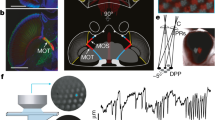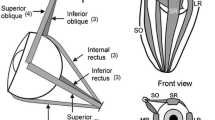Summary
Three types of behavior of the compound eye of Daphnia magna are characterized: ‘flick’, a transient rotation elicited by a brief flash of light; ‘fixation’, a maintained eye orientation in response to a stationary light stimulus of long-duration; ‘tracking’, the smooth pursuit of a moving stimulus. The magnitudes of the flick and fixation responses vary with stimulus position and are generally proportional to stimulus intensity, although at high intensities there is an attenuation of both behaviors. When the stimulus is placed at a position ∼80° dorsal to the eye axis, there is no response; this area is called the null region. For stationary stimuli in other positions, the direction of the response is such as to bring the stimulus closer to the null region. During tracking, the relative positions of the eye and stimulus change; the eye velocity is approximately half that of the moving stimulus. The regions of the eye in which these behaviors may be induced are different, being largest for flick and smallest for tracking. It is proposed that flick and fixation responses are a means for rotating the eye so that the stimulus is within the area surrounding the null region which is used for tracking.
Similar content being viewed by others
References
Collett TS, Land MF (1975) Visual control of flight behavior in the hoverfiy Syritta pipiens. J Comp Physiol 99:1–66
Consi TR, Macagno ER (1985) The spectral sensitivity of eye movements in response to light flashes in Daphnia magna. J Comp Physiol A 156:135–143
Consi TR, Macagno ER, Necles N (1987) The oculomotor system of Daphnia magna. The eye muscles and their motor neurons. Cell Tissue Res 247:515–523
Consi TR, Passani MB, Macagno ER (1987) The two-light experiment in Daphnia magna. Soc Neurose Abstr 13:137
Flaster MS, Macagno ER, Schehr RS (1982) Mechanisms for the formation of synaptic connections in the isogenic nervous system of Daphnia magna In: Spitzer NC (ed) Neuronal development. Plenum Press, New York, pp 267–296
Fraenkel G, Gunn DL (1961) The orientation of animals. Kineses, taxes and compass reactions. Dover, New York
Frost BJ (1975) Eye movements in Daphnia pulex (De Geer). J Exp Biol 62:175–187
Harris JE, Mason P (1956) Vertical migration of eyeless Daphnia. Proc R Soc Lond B 145:280–290
Harris JE, Wolfe UK (1955) A laboratory study of vertical migration. Proc R Soc Lond B 144:329–354
Lythgoe JN (1979) The ecology of vision. Clarendon Press, Oxford
Macagno ER, Lopresti V, Levinthal C (1973) Structure and development of neuronal connections in isogenic organisms: variations and similarities in the optic system of Daphnia magna. Proc Natl Acad Sci USA 70:57–61
Nalbach HO, Nalbach G (1987) Distribution of optokinetic sensitivity over the eye of crabs: its relation to habitat and possible role in the flow field analysis. J Comp Physiol A 160:127–135
Nilsson DE, Odselius R (1983) Regionally different optical systems in the compound eye of the water-flea Polyphemus (Cladocera, Crustacea). Proc R Soc Lond B 217:163–175
Odselius R, Nilsson DE (1983) Regionally different ommatidial structures in the compound eye of the water-flea Polyphemus (Cladocera, Crustacea). Proc R Soc Lond B 217:177–189
Ringelberg J (1964) The positively phototactic reaction of Daphnia magna Strauss. Neth J Sea Res 2:319–406
Ringelberg J, Flick BJG, Buis RC (1975) Contrast orientation in Daphnia magna and its significance for vertical plane orienta tion in the pelagic biotope in general. Neth J Zool 25:454–475
Röhlich P, Törö I (1965) Fine structure of the compound eye of Daphnia in normal, dark- and strongly light-adapted state. In: Rohen JW (ed) The structure of the compound eye. II. Symposium. Schattauer, Stuttgart, pp 175–186
Schehr RS (1984) Spectral sensitivities of anatomically identified photoreceptors in the compound eye of Daphnia magna. PhD Dissertation, Columbia University
Shaw SR, Stowe S (1982) Photoreception. In: Atwood HL, Sandeman DC (eds) The biology of Crustacea III. Neurobiology: structure and function. Academic Press, New York, pp 291–367
Sims SJ, Macagno ER (1985) Computer reconstruction of all the neurons in the optic ganglion of Daphnia magna. J Comp Neurol 233:12–29
Stearns SC (1975) Light responses of Daphnia pulex. Limnol Oceanogr 20:564–570
Wehner R (1981) Spatial vision in arthropods. In: Autrum H (ed) Vision in invertebrates (Handbook of sensory physiology vol. VII/6C). Springer, Berlin Heidelberg New York, pp 287–616
Young S (1981) Behavioural correlates in photoreception in Daphnia In: Laverack MS, Cosens DJ (eds) Sense organs. Blackie, Glasgow, pp 49–63
Young S (1988) Chasing with a model eye. J Exp Biol 137:399–410
Young S, Downing AC (1976) The receptive fields of Daphnia ommatidia. J Exp Biol 64:185–202
Young S, Taylor VA (1988) Visually guided chases in Polyphemus pediculus. J Exp Biol 137:387–398
Author information
Authors and Affiliations
Rights and permissions
About this article
Cite this article
Consi, T.R., Passani, M.B. & Macagno, E.R. Eye movements in Daphnia magna . J Comp Physiol A 166, 411–420 (1990). https://doi.org/10.1007/BF00204815
Accepted:
Issue Date:
DOI: https://doi.org/10.1007/BF00204815




